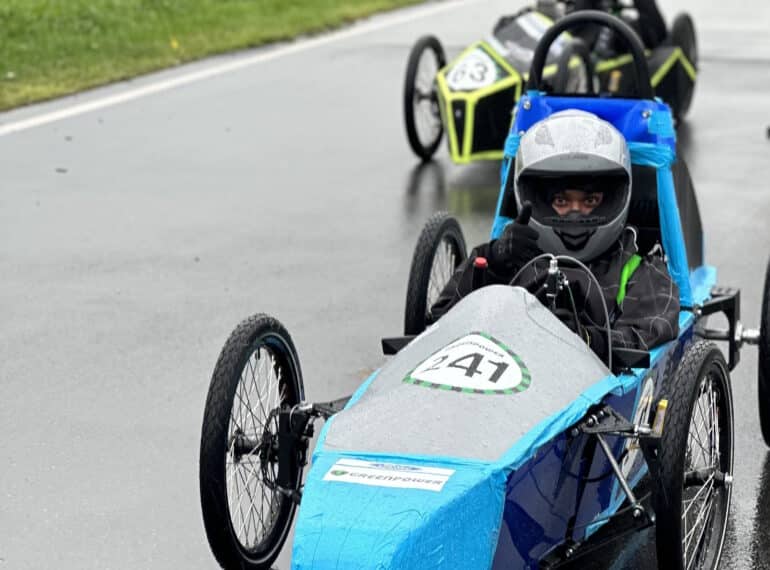
After two-and-a-half years of hard work, patience and perseverance, an electric car built by QE’s first Greenpower team overcame both mechanical challenges and terrible weather to perform strongly against much more experienced competitors in its first race.
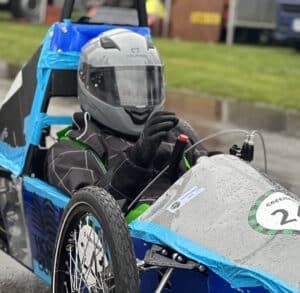 Having gathered information at the Dunsfold Park track in Surrey early in September, the Year 11 team travelled to Castle Combe in Wiltshire for their first competitive outing.
Having gathered information at the Dunsfold Park track in Surrey early in September, the Year 11 team travelled to Castle Combe in Wiltshire for their first competitive outing.
A mechanical failure in the first race threatened to scupper their efforts, but the pit crew overcame the odds to get the car – called New Horizon – ready for the starting grid just a couple of minutes before the start of the second, and final, F24 race of the day.
Congratulating the team, Head of Digital Teaching and Learning Michael Noonan said: “Torrential rain was abundant, and while many other cars either could not hold the track, or simply retired, our team stuck to their task: in the second race, they finished a highly respectable 44th out of 79 competitors – a feat all the more impressive given that they carried out an extra driver swap to give all our students a chance to drive.”
The event was one of a series of races run by the Greenpower Education Trust, a UK-based charity which aims to get young people enthusiastic about science and engineering.
The boys planned, built and refined the car using a Greenpower kit. Having promoted the car themselves, they won sponsorship from Horizon Builders, a North London construction, decorating and property maintenance company.
“Using the experience gained at Dunsfold Park, home to the BBC’s Top Gear, the students spent many late evenings (including a few quick runs around the School site) testing braking, circuitry, and speed,” said Mr Noonan.
Castle Combe is some 115 miles (186km) from the School, so the 12 team members had a 5.15am Sunday morning start on the day of the event. “They arrived in Wiltshire expecting a small crowd, given the early hour, but were instead greeted by the awesome sight of a total of 79 F24 (age 12–16) and 24 F24+ (age 16–24) teams in full flight with their preparations for the race day ahead. The sheer challenge which Greenpower would entail suddenly dawned on both staff and students!”
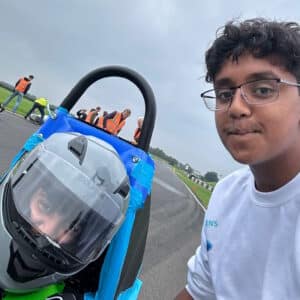 The boys duly threw themselves into preparing for the rigorous scrutineering process. “Following some adjustments to the braking system, and with the absolute minimum amount of time left, the team passed all tests, with only small notes on adjustments required for future races.
The boys duly threw themselves into preparing for the rigorous scrutineering process. “Following some adjustments to the braking system, and with the absolute minimum amount of time left, the team passed all tests, with only small notes on adjustments required for future races.
“From here, it was on to their first practice session – in some cases, students’ first experience of driving this car. The car, number 241 on the day, seemed to be performing admirably and was operating without fault. Each driver managed his session without any major issues, although it quickly because apparent that conditions were to worsen over the day, and that our performance would have to be adjusted to account for the wet weather.
“Following minor tweaks in the ‘paddock’, which had all the necessary tools and equipment, the first sets of drivers for the first race took to the grid. As the track lights signalled the commencement of the race, our relatively inexperienced team seemed to be punching above their weight; the last-minute aerodynamic and cooling adjustments provided for smooth racing.”
“It was at the point of driver change that a minor mechanical noise was noticed, and an inspection took place. With no obvious issue evident, the new driver took over and upon his first acceleration he managed to delink the chain! What had happened was that vibrations across the rear axle had loosened grub screws. With this looseness, the axle was ‘coasting’ left to right (which would slow the drive down enormously), and when our second driver took his seat and hit the throttle, the chain lodged against the chain guard at the link point and immediately disconnected!”
“The team was faced with disaster,” said Mr Noonan. “Having only covered 9.25 kilometres in their first race, they had to bow out just before the halfway point and immediately go about repairing the damage caused.”
With only two hours between races, the team had to strip back all mechanical items and re-assemble them to produce a working car. “Through sheer grit, determination and thanks in no small part to the kindness of other teams who happily supplied spare parts, New Horizon was race-ready with around two minutes to spare.”
 Buoyed by their success in reaching the tight deadline, the boys set about trying to better their first race score and duly achieved this, ending the day with a score of 22.59. (Greenpower F24 race results are determined by a formula based on furthest distance travelled within the 90-minute time period, taking the better figure from the two races.)
Buoyed by their success in reaching the tight deadline, the boys set about trying to better their first race score and duly achieved this, ending the day with a score of 22.59. (Greenpower F24 race results are determined by a formula based on furthest distance travelled within the 90-minute time period, taking the better figure from the two races.)
Afterwards, team members reflected on the day. Adithya Raghuraman said the team had been “nervous from anticipation leading up to the day”, but that it had proved a “memorable” experience. “Even the journey to the track was incredible, despite it being brutally early in the morning. Getting to meet and collaborate with other schools, scavenge for parts from fellow teams, and enthusiastically wait for our car to come around near our pit each lap, were all valuable chances to learn, compete, and most importantly, enjoy.”
His fellow teammate, Daksh Vinnakota, and Year 10 apprentice Keeyan Shah were both also thrilled with the experience: it had been “a good opportunity to finally demonstrate our work over the past two years in a competitive situation,” said Daksh, with Keeyan adding that the day had provided “a unique insight into professional racing”.
Although after the start of the 2023 Autumn Term , the Castle Combe races were in fact the final regional round in the 2022–2023 Greenpower season. The QE team are now handing over to Year 10 boys, who were their apprentices in the 2022-23 season, and will be mentoring and supporting them throughout the rest of the new season.
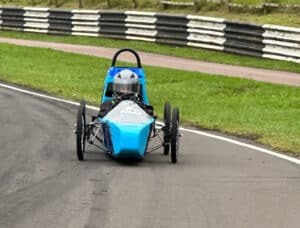 “As the season unfolds, the 2023–24 Greenpower team will be looking for around four willing Greenpower apprentices from Year 9 to join the cause and ‘upskill’ with a view to competing in Year 10,” said Mr Noonan.
“As the season unfolds, the 2023–24 Greenpower team will be looking for around four willing Greenpower apprentices from Year 9 to join the cause and ‘upskill’ with a view to competing in Year 10,” said Mr Noonan.
“This year’s team are already plotting a climb up the national leaderboard, which if they are fortuitous, will result in their participation at the Goodwood World Finals in October 2024.”
He added that the outgoing team had thanked their sponsors and the staff involved – Science teacher Timothy Panis and Technology assistant Felix Chillingworth, as well as himself – “for their support in finally seeing the Queen Elizabeth’s Greenpower team make their presence felt”.
Team members 2022–2023 season (current Year 11)
Soham Kale
Siddarth Oruganti
Rudra Patel
Adithya Raghuraman
Kavin Rameshshanker
Siraj Sidhu
Vinujan Sivakumar
Binaga Solangaarachchi
Ishanth Thangella
Daksh Vinnakota
Ethan Dias
Danyl Malchyk
Apprentices 2022–2023 season (current Year 10)
Taha Sebbar
Keeyan Shah
Dev Malde
Balaram Kataria
Yuvraj Patel
Ayush Saha
Parv Gandhi
Shashank Devaguptapu
Akshaj Vyas
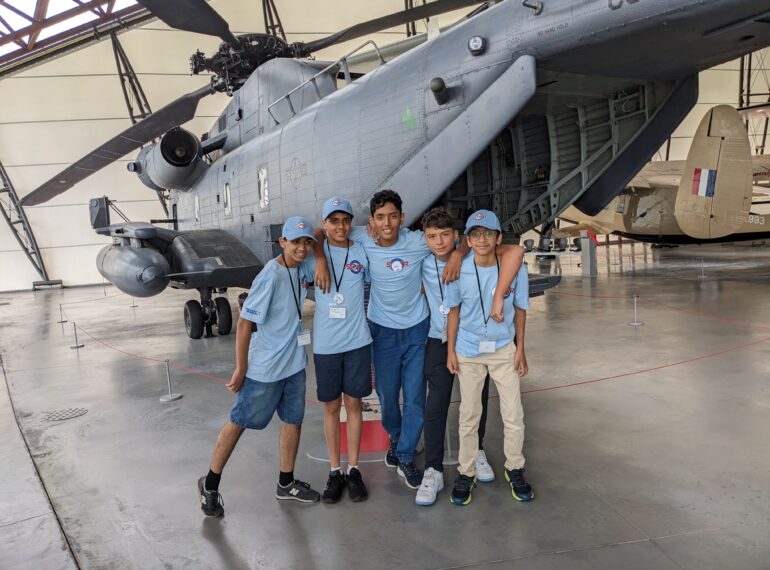
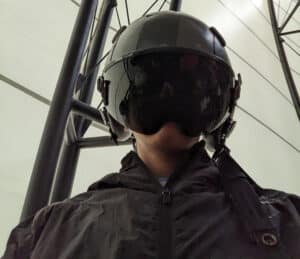 The group headed to Shropshire for the Summer Time Advanced Aerospace Residency (STAAR), at RAF Cosford, near Shifnal, and the nearby RAF Museum, learning from industry experts in a packed five-day programme.
The group headed to Shropshire for the Summer Time Advanced Aerospace Residency (STAAR), at RAF Cosford, near Shifnal, and the nearby RAF Museum, learning from industry experts in a packed five-day programme.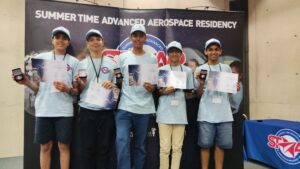 The QE five were among only 40 winners of the competition, which was open to those in Year 9 in 2022–2023. They were Keeyan Shah, Kyle Goldband, Neil Kulkarni, Keshav Aggarwal and Ishaan Mishra.
The QE five were among only 40 winners of the competition, which was open to those in Year 9 in 2022–2023. They were Keeyan Shah, Kyle Goldband, Neil Kulkarni, Keshav Aggarwal and Ishaan Mishra.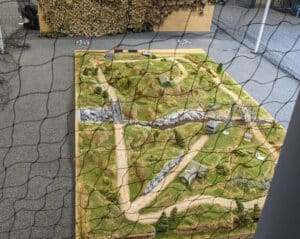 The competition to secure their places involved completing four STEM tasks relating to: decryption/encryption; reconnaissance; creating a CAD model, and creating a team presentation.
The competition to secure their places involved completing four STEM tasks relating to: decryption/encryption; reconnaissance; creating a CAD model, and creating a team presentation.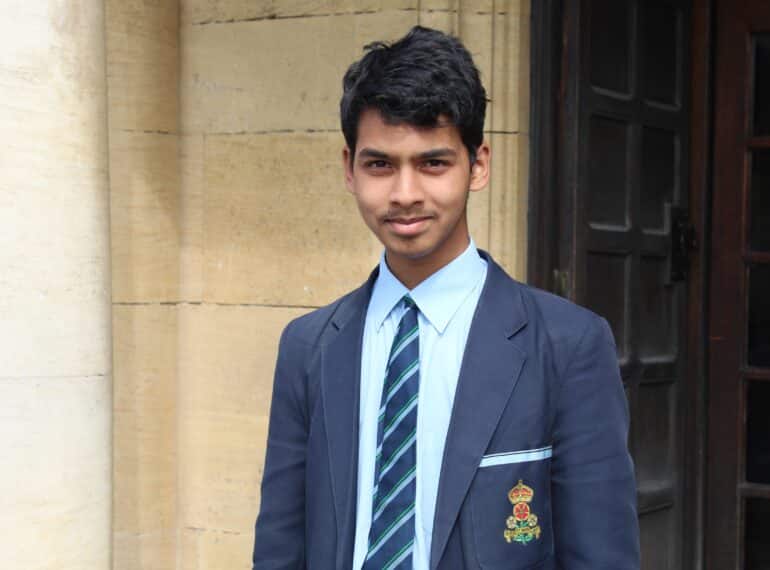
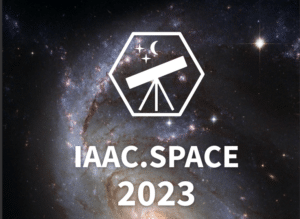 The final round, a multiple-choice online examination with 20 questions, was more about astrophysics knowledge. To prepare, he looked at previous years’ questions and also read around the subject. The round was sat online at home, but recorded to prove there had been no cheating.
The final round, a multiple-choice online examination with 20 questions, was more about astrophysics knowledge. To prepare, he looked at previous years’ questions and also read around the subject. The round was sat online at home, but recorded to prove there had been no cheating.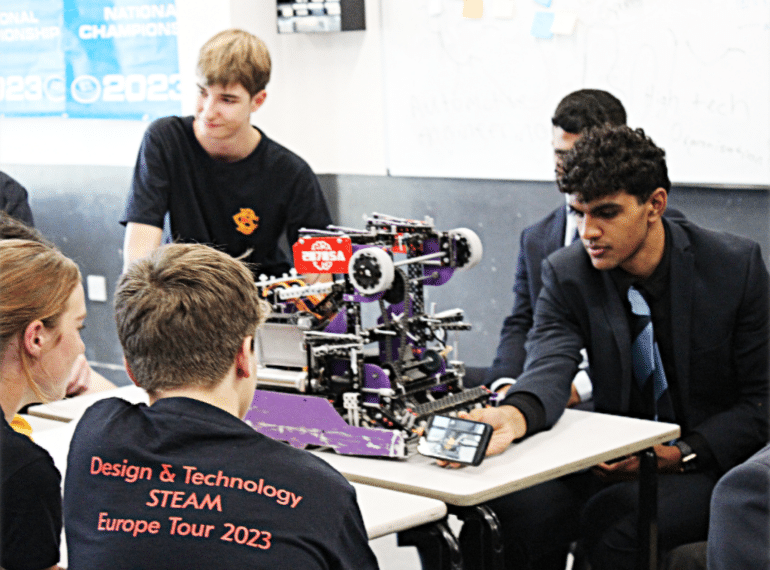
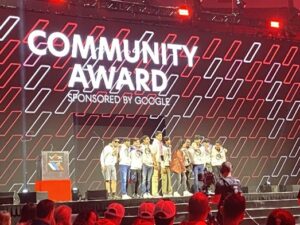 The six IQ (Year 8 and 9) and three VRC (Year 10) teams picked up a string of trophies in Dallas, while also taking time to sample the sights of the city.
The six IQ (Year 8 and 9) and three VRC (Year 10) teams picked up a string of trophies in Dallas, while also taking time to sample the sights of the city.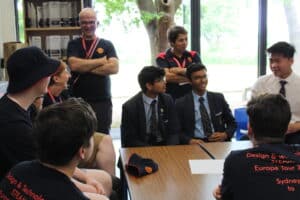 The 60-strong group of 15–17 year-old Australians called in during their trip to London and Paris. Their school, Barker College, is a large, high-achieving independent school on the North Shore of Sydney.
The 60-strong group of 15–17 year-old Australians called in during their trip to London and Paris. Their school, Barker College, is a large, high-achieving independent school on the North Shore of Sydney.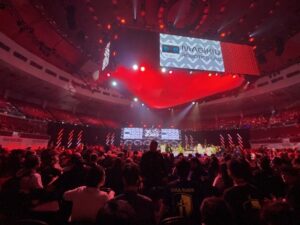 At the senior level, the 19 VRC competitors collectively came away with six awards, including an Inspire Award and the Promote Video Online Challenge Award. Two of the three teams – Nova and Shattersquad – battled through tough early competition and successfully made it through to their divisional knockout stages.
At the senior level, the 19 VRC competitors collectively came away with six awards, including an Inspire Award and the Promote Video Online Challenge Award. Two of the three teams – Nova and Shattersquad – battled through tough early competition and successfully made it through to their divisional knockout stages.
 After working for global software firm Autodesk, based in San Francisco, Arian (OE 1998–2003) raised venture capital and successfully spun out its additive manufacturing team to form Holo, while also transitioning its technology from the 3D printing of polymers to metals. Six-and-a-half years later, Holo is at the forefront of innovation, using its proprietary digital platform to enable the manufacturing at scale of high-performance parts across a range of materials, including metals, ceramics and composites. Holo is supported by top-tier Silicon Valley investors and strategic partners.
After working for global software firm Autodesk, based in San Francisco, Arian (OE 1998–2003) raised venture capital and successfully spun out its additive manufacturing team to form Holo, while also transitioning its technology from the 3D printing of polymers to metals. Six-and-a-half years later, Holo is at the forefront of innovation, using its proprietary digital platform to enable the manufacturing at scale of high-performance parts across a range of materials, including metals, ceramics and composites. Holo is supported by top-tier Silicon Valley investors and strategic partners. Head of Technology Michael Noonan said: “Arian provided Year 12 with a workshop which firstly covered his professional journey to date, from his early days post PhD working on founding his own company (The Invention Works) through to his position as Senior Principal Engineer at Autodesk. Most of the workshop, however, focussed on his current company, Holo. He explained that he and the other co-founders could see the enormous potential to create a viable business in this area and so pursued it as an opportunity.”
Head of Technology Michael Noonan said: “Arian provided Year 12 with a workshop which firstly covered his professional journey to date, from his early days post PhD working on founding his own company (The Invention Works) through to his position as Senior Principal Engineer at Autodesk. Most of the workshop, however, focussed on his current company, Holo. He explained that he and the other co-founders could see the enormous potential to create a viable business in this area and so pursued it as an opportunity.” The instrument should have six degrees of freedom
The instrument should have six degrees of freedom In the lunchtime talk to Year 10, Arian took a more personal look at his story, beginning with his time at QE, when he was in Stapylton House and was a musician and prefect.
In the lunchtime talk to Year 10, Arian took a more personal look at his story, beginning with his time at QE, when he was in Stapylton House and was a musician and prefect.
 This year, QE sent six teams to the VRC National Championships at Telford International Centre for the first time. With six junior teams also making the journey, Queen Elizabeth’s School had more teams at the national finals than any other organisation.
This year, QE sent six teams to the VRC National Championships at Telford International Centre for the first time. With six junior teams also making the journey, Queen Elizabeth’s School had more teams at the national finals than any other organisation. The QE boys benefitted from the support of corporate sponsor, Kingston Technology, sporting QE hoodies bearing the Kingston logo.
The QE boys benefitted from the support of corporate sponsor, Kingston Technology, sporting QE hoodies bearing the Kingston logo. As the final stages progressed, high-performing QE sides found themselves facing each other, with Typhoon defeating Shattersquad in a Lovelace quarter-final and Nova beating Hybrid in a Brunel semi-final.
As the final stages progressed, high-performing QE sides found themselves facing each other, with Typhoon defeating Shattersquad in a Lovelace quarter-final and Nova beating Hybrid in a Brunel semi-final. It was not to be, however. After a complicated series of events started when illegal parts were spotted on another team’s robot, Typhoon had to battle against the disadvantage of having to disable part of their own robot. They fought bravely alongside their alliance partner, but in the end, lost their deciding game by a single point, 133-134. “Divisional runners up, their pride was still intact and they learned a great deal from this experience,” said Mr Noonan.
It was not to be, however. After a complicated series of events started when illegal parts were spotted on another team’s robot, Typhoon had to battle against the disadvantage of having to disable part of their own robot. They fought bravely alongside their alliance partner, but in the end, lost their deciding game by a single point, 133-134. “Divisional runners up, their pride was still intact and they learned a great deal from this experience,” said Mr Noonan.